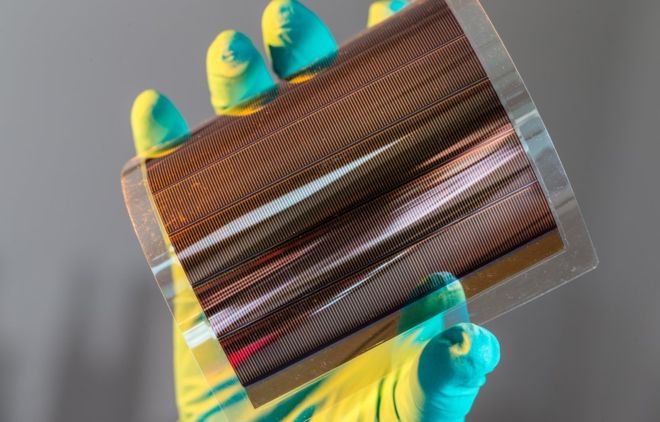A new study pushes organic solar cell efficiency beyond 17% with the authors saying that up to 25% is possible.
This is important because according to estimates, with a 15% efficiency and a 20 year lifetime, organic solar cells could produce electricity at a cost of less than 7 cents per kilowatt-hour.
Flexible, printed solar cells can work indoors and they can be made semi-transparent, so they could be incorporated into windows and generate power during daylight.

Science – Organic and solution-processed tandem solar cells with 17.3% efficiency
Abstract
Though organic photovoltaic cells (OPVs) have many advantages, their performance still lags far behind that of other photovoltaic platforms. One of the most fundamental reasons for this is the low charge mobility of organic materials, leading to a limit on the active layer thickness and efficient light absorption. In this work, guided by a semi-empirical model analysis and using the tandem cell strategy to overcome such issues, and taking advantage of the high diversity and easily tunable band structure of organic materials, a record and certified 17.29% power conversion efficiency for a 2-terminal monolithic solution processed tandem OPV is achieved.

Brian Wang is a Futurist Thought Leader and a popular Science blogger with 1 million readers per month. His blog Nextbigfuture.com is ranked #1 Science News Blog. It covers many disruptive technology and trends including Space, Robotics, Artificial Intelligence, Medicine, Anti-aging Biotechnology, and Nanotechnology.
Known for identifying cutting edge technologies, he is currently a Co-Founder of a startup and fundraiser for high potential early-stage companies. He is the Head of Research for Allocations for deep technology investments and an Angel Investor at Space Angels.
A frequent speaker at corporations, he has been a TEDx speaker, a Singularity University speaker and guest at numerous interviews for radio and podcasts. He is open to public speaking and advising engagements.


Roll out solar panels: https://www.youtube.com/watch?v=M9MAZLhm_9k Flexible organic cells might change the solar business model. You can factory pre-fab 500kW. The installation process is 1) set container, 2) roll out panels, 3) connect to power system. Days instead of months, very few skilled worker hours. Shorter life might be acceptable. Replacing organic cells every 5 years might be cheaper than installing silicon in glass once for 20 yrs.
Roll out solar panels: https://www.youtube.com/watch?v=M9MAZLhm_9k Flexible organic cells might change the solar business model. You can factory pre-fab 500kW. The installation process is 1) set container 2) roll out panels 3) connect to power system. Days instead of months very few skilled worker hours.Shorter life might be acceptable. Replacing organic cells every 5 years might be cheaper than installing silicon in glass once for 20 yrs.
But being organic they fade away in a week or two…
But being organic they fade away in a week or two…
Semi-transparent windows: it’s not just for low-riders any longer.
Semi-transparent windows: it’s not just for low-riders any longer.
Roll out solar panels: https://www.youtube.com/watch?v=M9MAZLhm_9k
Flexible organic cells might change the solar business model. You can factory pre-fab 500kW. The installation process is 1) set container, 2) roll out panels, 3) connect to power system. Days instead of months, very few skilled worker hours.
Shorter life might be acceptable. Replacing organic cells every 5 years might be cheaper than installing silicon in glass once for 20 yrs.
But being organic they fade away in a week or two…
Semi-transparent windows: it’s not just for low-riders any longer.